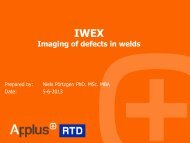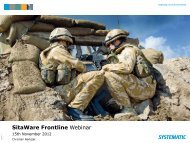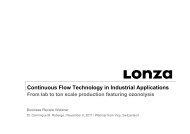Integrated Survivability - Business Review Webinars
Integrated Survivability - Business Review Webinars
Integrated Survivability - Business Review Webinars
Create successful ePaper yourself
Turn your PDF publications into a flip-book with our unique Google optimized e-Paper software.
<strong>Integrated</strong> <strong>Survivability</strong><strong>Business</strong> <strong>Review</strong> Webinar27 th September 2012William SuttieLand Battlespace Systems Departmentwksuttie@dstl.gov.ukAll pictures Crown Copyright
Role of Dstl• The Defence Science and Technology Laboratory (Dstl) ispart of the UK Ministry of Defence• Dstl is responsible for:– Research in critical or sensitive technology areas– Operational Analysis– Support to operations– Expert advice to inform UK MoD research and procurement• The <strong>Integrated</strong> <strong>Survivability</strong> Group in Land BattlespaceSystems Department of Dstl has been developing tools,methodologies and databases for MOD, required to takean integrated approach to survivability© Dstl 2012Dstl is part of theMinistry of Defence
The <strong>Survivability</strong> Challenge© Dstl 2012Dstl is part of theMinistry of Defence
The drive for survivability• Crew survivability is a high priority, especially to:– Minimise casualties in peace support and peace enforcementoperations– Minimise serious injuries• Platform robustness is becoming increasingly important• There are significant challenges and constraints© Dstl 2012Dstl is part of theMinistry of Defence
1: The Changing/Uncertain Threat• Unconventional threats can evolve quickly• The future area of operations is not known:– Climatic and weather effects– Terrain impacts• Impact of Rules of Engagement (ROE) and other politicaldrivers© Dstl 2012Dstl is part of theMinistry of Defence
2: Constraints• Vehicle Weight:– Armour is very effective but adds weight– Increased weight reduces strategic mobility, terrain accessibility andreliability and increases support requirements• Finance:– Limits fleet types and size and the use of expensive technologies• Platform Specialisation:– Recently fielded solutions optimised against specific threats© Dstl 2012Dstl is part of theMinistry of Defence
The Solution:<strong>Integrated</strong> <strong>Survivability</strong>?© Dstl 2012Dstl is part of theMinistry of Defence
<strong>Integrated</strong> <strong>Survivability</strong> (IS)• Aims to optimise the mix of survivability measures withingiven constraints• It takes into account all platform capabilities and attributes• Maximises synergies between systems, data & infrastructures• Contributors to IS include:– <strong>Survivability</strong> Technologies– Other vehicle capabilities– Networked information and systems– Tactics, Techniques and Procedures• ‘<strong>Survivability</strong> Onion’© Dstl 2012Dstl is part of theMinistry of Defence
Don’t be there:SA and NECMinimise behindarmour effects,damage loss offunctionality andcasualties© Dstl 2012Dstl is part of theMinistry of Defence
Key Issues: What Mix of the Potential Solutions?ARMOURSTEALTHCAMOUFLAGEDEFENSIVEAID SYSTEMSCOUNTER-FIREPYROTECHNICSSITUATIONAL AWARENESSMOBILITYAll Pictures © Crown Copyright© Dstl 2012Dstl is part of theMinistry of Defence
<strong>Survivability</strong> Technologies (1)• Primary Measures– Armour– Signatures– Defensive Aid Suites, Active Protection Systems• Other Measures– Nuclear Biological Chemical (NBC) Collective Protection– Combat Identification– Fire and explosion suppression– Electro-Optic Protection Measures– Camouflage Concealment & Deception– Mine Detection/Route proving© Dstl 2012Dstl is part of theMinistry of Defence
<strong>Survivability</strong> Technologies (2)• Secondary Contributors– Mobility– Situational Awareness– Counterfire• Design Considerations– Citadel Approach– Unmanned Turret– Layout, redundancy, hardening© Dstl 2012Dstl is part of theMinistry of Defence
IS Technology Focus• The main focus for IS is balancing the main technologyareas to minimise the threat from ballistic attack:– Armour– Active protection– Signature management• Other measures reduce risk and should be considered• Damage reduction and mitigation is increasingly important© Dstl 2012Dstl is part of theMinistry of Defence
Armour© Dstl 2012Dstl is part of theMinistry of Defence
Potential Armour Technologies• Metallic Armour (Steel, Aluminium, Titanium)• Bar Armour, Tarrion• Ceramics• Explosive Reactive Armours (ERA)• Multi-layer armours• Electric armours• Anti-Spall liners to reduce behind armour effects© Dstl 2012Dstl is part of theMinistry of Defence
Armour Technologies - Trends• Armour remains the most robust survivability solution– User confidence– Passive solutions reliable– Applicable across a wide range of scenarios– Good mass efficiency for Reactive Armours• Weight & performance improvements are likely through:– Improved ERA– Low Cost Ceramics– Improved materials giving lower through life costs and improvedblast protection• Other developments could include more use ofcomposite structures and electric armour© Dstl 2012Dstl is part of theMinistry of Defence
Ceramic armours• High mass efficiencies against Kinetic Energythreats• Dstl has demonstrated solutions with:– improved mass efficiency– improved (dynamic) multi-hit capability– reduced edge effects• Reduced costs and high performance will lead tomore use of ceramic armour solutions© Dstl 2012Dstl is part of theMinistry of Defence
Electric Armours• Electromagnetic launch systems demonstrated• Direct electrification systems to counter Chemical Energy(CE) threats demonstrated and shown to be promising• Significant risks remain regarding power supplies andintegration© Dstl 2012Dstl is part of theMinistry of Defence
DSTL Demonstration of an ElectricArmour System defeating RPG7© Dstl 2012Dstl is part of theMinistry of Defence
ACAVP (Advanced CompositeArmoured Vehicle Platform)GRP Hull with armour modulesFoxhound –composite crewcompartment© Dstl 2012Dstl is part of theMinistry of Defence
Signature Management© Dstl 2012Dstl is part of theMinistry of Defence
Signature Management Technologies• Thermal, Radar and Acoustic Signature Managementtechniques well understood, demonstrated and inservice• Significant reductions in detection probability and rangeare possible• Designed in signature management has low cost andweight impact• A range of materials and techniques have beendeveloped and demonstrated© Dstl 2012Dstl is part of theMinistry of Defence
Signature Management Effectiveness• Signature Management will:– Reduce probability of detection by surveillance assets– Reduce effectiveness of Terminally Guided Munitions– Reduce probability of detection and targeting– Enhance performance of decoys and obscurants– Support acquisition stand off• BUT:– <strong>Survivability</strong> benefits can be difficult to quantify– Effectiveness not guaranteed© Dstl 2012Dstl is part of theMinistry of Defence
…and Signature Management will not beapplicable to all types of operation© Dstl 2012Dstl is part of theMinistry of Defence
Active Protection© Dstl 2012Dstl is part of theMinistry of Defence
Active Protection System Technology• DAS or APS covers hard and soft kill solutions• A wide range of APS technologies available coveringdetection & countermeasures– Detection: Laser Warners, Radar Warners, Retroreflection,Passive Electro-Optic, Active Radar– Countermeasures: Obscurants, jammers, decoys, beacons, blastcountermeasures, fragmentation grenades© Dstl 2012Dstl is part of theMinistry of Defence
Active Protection Exploitation• Much APS technology has been demonstrated and ismature• Some APS solutions have been fielded• Work on improved detection systems and hard-killsystems is on-going• The use of active protection solutions is likely to increasesignificantly in the future• Research into active mine protection solutions is ongoing© Dstl 2012Dstl is part of theMinistry of Defence
<strong>Survivability</strong> Optimisation© Dstl 2012Dstl is part of theMinistry of Defence
Optimisation Drivers• In view of the range of survivability technologies andsolutions means of optimising survivability solutions isrequired– Required at the design stage and through life– Mission specific optimisation will be a developing trend– Residual risks must be understood• The large numbers of technologies and design solutionsleads to a large potential solution domain© Dstl 2012Dstl is part of theMinistry of Defence
<strong>Survivability</strong> Optimisation• UK MoD has been developing an understanding of howto approach <strong>Integrated</strong> <strong>Survivability</strong>• The approach is being supported by:– Baselining the survivability of platforms– Databases and expertise– Tools including vulnerability codes and the ISAAC tool• A Desk Officers Guide (DOG) has been developed• The basic principles of defined in the DOG are nowdefined in the Acquisition Organisation Framework© Dstl 2012Dstl is part of theMinistry of Defence
The ISAAC Tool (1)• <strong>Integrated</strong> <strong>Survivability</strong> Assessment and Analysis Code• Threat and scenario driven high level tool to undertakeinitial optimisation of survivability technologies• Tool Inputs– Weighted threat list– <strong>Survivability</strong> technologies– Technology effectiveness and burden data– Conflicts and synergies• Tool Output– Relative ‘Figure of Merit’ for different combinations oftechnologies within defined cost, weight or other burden limits© Dstl 2012Dstl is part of theMinistry of Defence
The ISAAC Tool (2)• Uses a survivability chain to allocate effectiveness– Impact on probability of detection, acquisition, hit and kill• Assumes worst case threat sensor and weapon is used• Calculations– Exhaustive enumeration– Identifies mixes of technologies – survivability concepts• Results analysis– Compares solutions– Identifies the contribution of each technology– Identifies residual vulnerabilities© Dstl 2012Dstl is part of theMinistry of Defence
Indicative ISAAC Input and Outputformats. Dummy data only© Dstl 2012Dstl is part of theMinistry of Defence
Indicative ISAAC OutputBest Solutionsfor further studyGood; butunaffordableUnacceptablePerformance© Dstl 2012Dstl is part of theMinistry of Defence
ISAAC for Capability Gap Analysis0.140.12Probabilityof KillGiven anEncounter0.10.080.060.04C3 Pk WEIGHTEDC3 Pk UNWEIGHTED0.020AK47HMGRPG7IFVIFV ADVANCEDLAFVATGWMBT BASICMBT ADVANCEDARTY DUMBARTY ADVANCEDNB Indicative results only© Dstl 2012Dstl is part of theMinistry of Defence
Typical Technology Effectiveness Assessment<strong>Survivability</strong> Benefit20151050OpenUrbanBaseline+ Enh Roof+ Enh Mine+ Stealth+ S-DAS+ H-DASBestTechnologyThis graph shows indicative results for the percentage performanceimprovements in survivability when different technologies are addedto a baseline platform with limited armour protection along with thatfor the best overall mix allowable within the weight constraints© Dstl 2012Dstl is part of theMinistry of Defence
Modular Approach to <strong>Survivability</strong>Technology Integration© Dstl 2012Dstl is part of theMinistry of Defence
• Needed to:Modular <strong>Survivability</strong>– Optimised survivability for scenarios– Rapid response to new threats– Support cost effective technology insertion• Hence modular and flexible platform solutions arerequired that include:– Modular Armour Fits– Electronic Infrastructure– Tailored Appliqué paints and coatings© Dstl 2012Dstl is part of theMinistry of Defence
Modular Armour Fits• Use of standardised fixings for appliqué armour• Armour can be tuned to meet threat mix• Allows rapid exploitation of new armour technologies• Bulk of protection is in appliqué rather than base armour© Dstl 2012Dstl is part of theMinistry of Defence
Electronic Infrastructure (1)• An electronic infrastructure supports:– The ability to match active protection fit to the threat scenario– Reduced integration costs and risks– Rapid technology integration and spiral development– Data exploitation between sub-systems– Reduced crew workload© Dstl 2012Dstl is part of theMinistry of Defence
Electronic Infrastructure (2)• Electronic Infrastructure includes:– Databus architecture– Power architecture– Man Machine Interface (MMI)– Defined data and middleware standards• It should provide:– An open and modular high integrity databus– Accessible power– A reconfigurable MMI© Dstl 2012Dstl is part of theMinistry of Defence
Electronic Infrastructure Definition• Requirements are defined in Defence Standard 05-23 –Generic Vehicle Architecture• This defines mandated aspects of platform architectures• Supported by the Land Data Model• Open and modular electronic infrastructure to supportsurvivability solutions was demonstrated by the VehicleTechnology Integration Demonstrator (VTID) programme© Dstl 2012Dstl is part of theMinistry of Defence
VTID (1)• 3 year MOD research programme by UK Consortium– Included QinetiQ, THALES, BAES, Ultra, etc• Defined and demonstrated the infrastructure required tosupport modular survivability fits• The scope covers physical, data, electrical, power,software and crew interface requirements• VTID demonstration, validation and user trials using:– System emulations– Hardware based system integration laboratory– Demonstration using an FV432© Dstl 2012Dstl is part of theMinistry of Defence
VTID Outputs• Data of subsystem performance• Synthetic Environment modelling• Software validation• Modular safety cases• Through Life Cost Modelling tool• Impact of TTPs• Architecture and MMI lessons• User trials and feedback• Demonstration of feasibility of the VTID concept– Wide range of technologies integrated– Major IS refit undertaken in 45 minutes by the crew© Dstl 2012Dstl is part of theMinistry of Defence
DazzlesystemRemoteWeaponStationEnhancedSensorsVTID ConceptCountermeasureLauncherCommonInfrastructureLWRMAWAcousticHFIEnhancedSACBRNSensorsObscurantsandCountermeasures© Dstl 2012Dstl is part of theMinistry of Defence
Modular Approach to Coatings• Traditionally different colour schemes used for differentgeographic areas or for winter operations• Emerging technologies facilitate the ability to tune thepaint coating to the threat and environment covering:– Colour– Chemical Agent Absorption– Near Infra-Red reflection– Emissivity– RF absorption– Solar Load Reduction© Dstl 2012Dstl is part of theMinistry of Defence
Conclusions• The challenge of maintaining acceptable levels of crewsurvivability in an ever changing threat environmentleads to:– An integrated survivability approach that exploits all appropriatetechnologies– Infrastructure that supports the rapid solution improvementsthrough reconfiguration, technology upgrades or technologyinsertions– Tools that enable the development of optimum solutions whichmeet other constraints© Dstl 2012Dstl is part of theMinistry of Defence
Questions© Dstl 2012Dstl is part of theMinistry of Defence
















